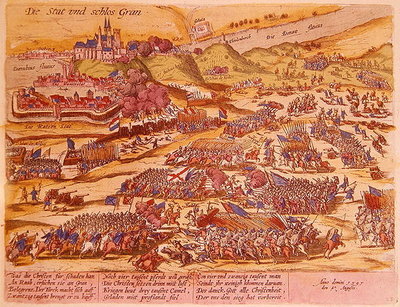The war was a series of conflicts between the Habsburgs and their close allies against the Ottoman Empire.
Belligerents:
- Habsburg Austria
- Holy Roman Empire
- Spain
- Papal States
- Bohemia
- Kingdom of Croatia
- Hungarian Kingdom of Ferdinand's
- The Ottoman Empire
- Moldavia
- Hungarian Kingdom of Szapolyai's
- Wallachia Serbain Despotate
- France
 |
| Wood Engraving of the clash between the Austrians and Ottoman's outside of Vienna in 1529 (PD-OLD) |
The Austrian success in Hungary frustrated Suleiman to the point that he would attempt to conquer Vienna again in 1532, with an attacking army of approximately 150,000. Ferdinand, realising how massive Suleiman's force was, withdrew his army from the boarder city of Koszeg, and left fewer than 700 men to defend the city, without any canons. The Grand Vizier of the Ottoman Empire, Ibrahim Pasha, did not understand how poorly defended the city of Koszeg was, and placed the city under siege for more than four weeks. With the arrival of the August rains, the Ottoman army withdrew and returned home.
Despite the second failed attempt at capturing Vienna, the Ottoman's and Austrians signed a peace treaty, which recognised the Kingdom of Hungary as an Ottoman vassal, as long as the Ottoman's respected the regions of Hungary that had recognised Habsburg rule.
This peace deal did not end the war between the two rivals. The war would turn bloody again at the Siege of Osijek (1537), where Ferdinand and his massive Austrian army, which was well trained and equipped thanks to the success of his defending force at Koszeg, planned a massive blow to the Ottoman strong hold of Osijek. This attack would directly violate the treaty. At the Battle of Dakovo, the Austrian attempt would be futile, and faced a crushing defeat, leaving more than 25,000 Austrians dead or wounded and minimal loses to the Ottoman defencive force. Less than a year later at the Battle of Preveza, in 1538, the Ottoman army would again crush the Habsburg led coalition.
Looking to make up for the humiliating defeats of the previous two years, the Austrians would attempt to capture Buda in 1541. The Habsburg's luck was still no where to be found. After the humiliating defeat at the Siege of Buda, the Hungarian King (Disputed) John Szapolyai died in 1540, and an appeal by his widdow to end the war went unanswered.
By 1543, it was clear the Ottoman Empire would win this war. Their alliance with France was stronger than ever, and France even agreed to aid the Ottoman army during the Campaign of Suleiman in 1543, supplying troops, and artillery units. These played a direct role in the success of the Ottomans at the Siege of Esztergom and the capture of Hungarian cities Szekesfehervar, Siklos, and Szged, and the protection of another Austrian attack on the city of Buda.
 |
At the end of 1543, the Ottoman's and Austrians came to another peace agreement, which would last until 1552 when Suleiman decided he required the city of Eger to be within the limits of the Ottoman Empire. It was a humiliating defeat, where a professional army was defeated by the citizens of Eger withstanding the annexation.
While other conflicts between the Ottoman Empire, Austria, and Hungary would arise, this ended the Little War in Hungary. Especially as this was just one of the many Ottoman-Habsburg Wars
For more information on this subject, please read:
- The Ottoman Empire 1326-1699 by Stephen R. Turnbull (2003)
- The Enemy at the Gate: Habsburg, Ottomans, and the Battle for Europe by Andre Wheatcroft (2010)
- Plus all the other great books on Ottoman and Austrian history
Remembering History - The Little War in Hungary 1530-1552
No comments:
Post a Comment